CF3-substituted carbocations: underexploited intermediates with great potential in modern synthetic chemistry
- PMID: 33828616
- PMCID: PMC7871035
- DOI: 10.3762/bjoc.17.32
CF3-substituted carbocations: underexploited intermediates with great potential in modern synthetic chemistry
Abstract
"The extraordinary instability of such an "ion" accounts for many of the peculiarities of organic reactions" - Franck C. Whitmore (1932). This statement from Whitmore came in a period where carbocations began to be considered as intermediates in reactions. Ninety years later, pointing at the strong knowledge acquired from the contributions of famous organic chemists, carbocations are very well known reaction intermediates. Among them, destabilized carbocations - carbocations substituted with electron-withdrawing groups - are, however, still predestined to be transient species and sometimes considered as exotic ones. Among them, the CF3-substituted carbocations, frequently suggested to be involved in synthetic transformations but rarely considered as affordable intermediates for synthetic purposes, have long been investigated. This review highlights recent and past reports focusing on their study and potential in modern synthetic transformations.
Keywords: carbocation; organic synthesis; superelectrophile; trifluoromethyl.
Copyright © 2021, Fernandes et al.
Figures



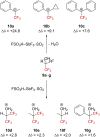

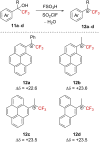




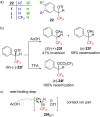




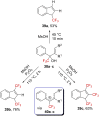












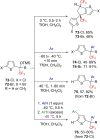

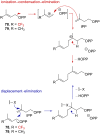






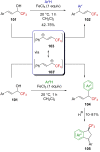
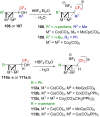
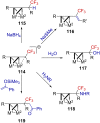
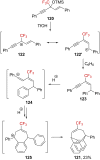
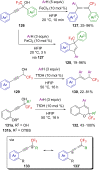


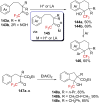

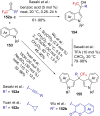

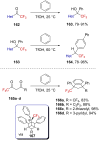















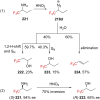

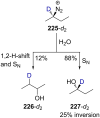






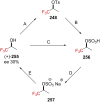



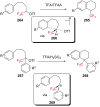




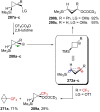



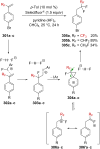







Similar articles
-
Ultrafast C-C and C-N bond formation reactions in water microdroplets facilitated by the spontaneous generation of carbocations.Chem Sci. 2023 Oct 4;14(41):11515-11520. doi: 10.1039/d3sc03870j. eCollection 2023 Oct 25. Chem Sci. 2023. PMID: 37886101 Free PMC article.
-
Electrochemically Generated Carbocations in Organic Synthesis.Angew Chem Int Ed Engl. 2024 Oct 24;63(44):e202407207. doi: 10.1002/anie.202407207. Epub 2024 Sep 20. Angew Chem Int Ed Engl. 2024. PMID: 39075778 Review.
-
Catalytic asymmetric C-H insertion reactions of vinyl carbocations.Science. 2022 Dec 9;378(6624):1085-1091. doi: 10.1126/science.ade5320. Epub 2022 Dec 8. Science. 2022. PMID: 36480623 Free PMC article.
-
Carbocation chemistry confined in zeolites: spectroscopic and theoretical characterizations.Chem Soc Rev. 2022 Jun 6;51(11):4337-4385. doi: 10.1039/d1cs00966d. Chem Soc Rev. 2022. PMID: 35536126 Review.
-
Aqueous Microdroplets Capture Elusive Carbocations.J Am Chem Soc. 2021 Feb 17;143(6):2459-2463. doi: 10.1021/jacs.0c12512. Epub 2021 Feb 3. J Am Chem Soc. 2021. PMID: 33534557
Cited by
-
Formation of synthetically relevant CF3-substituted phenonium ions in superacid media.RSC Adv. 2021 Jul 26;11(41):25695-25699. doi: 10.1039/d1ra04901a. eCollection 2021 Jul 19. RSC Adv. 2021. PMID: 35478903 Free PMC article.
-
Cyclization of 1-aryl-4,4,4-trichlorobut-2-en-1-ones into 3-trichloromethylindan-1-ones in triflic acid.Beilstein J Org Chem. 2023 Sep 27;19:1460-1470. doi: 10.3762/bjoc.19.105. eCollection 2023. Beilstein J Org Chem. 2023. PMID: 37799178 Free PMC article.
-
5,5,5-Trichloropent-3-en-one as a Precursor of 1,3-Bi-centered Electrophile in Reactions with Arenes in Brønsted Superacid CF3SO3H. Synthesis of 3-Methyl-1-trichloromethylindenes.Molecules. 2022 Oct 7;27(19):6675. doi: 10.3390/molecules27196675. Molecules. 2022. PMID: 36235211 Free PMC article.
References
-
- Olah G A, Reddy V P, Prakash G K S. Chem Rev. 1992;92:69–95. doi: 10.1021/cr00009a003. - DOI
-
- Olah G A, Prakash G K S, Molnár Á, et al. Superacid Chemistry. 2nd ed. Hoboken, NJ, USA: John Wiley & Sons; 2009. - DOI
-
- Gassman P G, Tidwell T T. Acc Chem Res. 1983;16:279–285. doi: 10.1021/ar00092a003. - DOI
-
- Tidwell T T. Angew Chem, Int Ed Engl. 1984;23:20–32. doi: 10.1002/anie.198400201. - DOI
Publication types
LinkOut - more resources
Full Text Sources
Other Literature Sources
Miscellaneous
